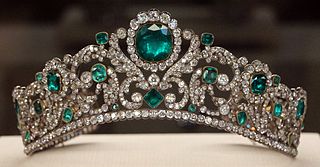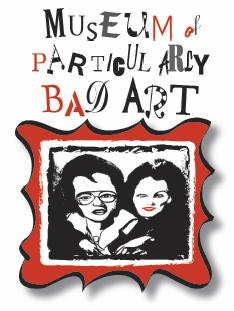
Leila's Hair Museum is a museum in Independence, Missouri that displays examples of hair art dating back to the 18th century.

Leila's Hair Museum is a museum in Independence, Missouri that displays examples of hair art dating back to the 18th century.
Hair art was a form of art that began in the 16th century or earlier, and flourished in the Victorian era. A collection of hair from family, friends, or a gathering such as a wedding, was made into a hair wreath by making flowers of the hair. It was then put into a shadow box frame. Wreaths were also made as memorial pieces using hair from the deceased. It was used by people wanting to keep a memento of a loved one before the invention of photography. [1] This form of art also consisted of necklaces, bracelets, rings, lockets, paintings and medallions embellished with strands of hair. [1]
Leila Cohoon is a retired cosmetology teacher living in Independence, Missouri.
Leila founded the Independence College of Cosmetology. [2] She started collecting hair in 1956 and considers it to be her life work. [3] She was always fascinated with hair as a child and believes it is one of the most unusual parts of the human body. She opened the hair museum in 1986 in a small front room in her cosmetology school. [2] She did this because she was running out of space for the collection of hair art that she had built up over the years. Later, she moved her hair museum a few blocks from the old location so as to be able to expand. [4] The new location for the museum consists of several rooms with their walls covered with the hair art from top to bottom . [2]
Leila’s museum has 600+ wreaths and over 2,000 pieces of jewelry which includes locks of hair dating from the 18th century and earlier. Her oldest exhibit is a brooch dated 1680. [5] Many framed items are over a hundred and fifty years old. These include one which is an assemblage of hair from every member of a chapter of the League of Women Voters, and two made of hair shorn from sisters that both entered a convent. [2] There are also exhibits that include the hair of famous people. Elvis Presley is represented; Michael Jackson is present as well, and the museum appeared in a Jeopardy question on December 30, 2016, reflecting this. [6] There is also hair from George Washington, Abraham Lincoln, Daniel Webster, Aaron Burr, Marilyn Monroe, singer Jenny Lind and Queen Victoria. [7] Leila is not as interested in collecting the hair of famous people as she is in preserving hair art.

Independence is the fifth-largest city in Missouri and the county seat of Jackson County. Independence is a satellite city of Kansas City, Missouri, and is the largest suburb on the Missouri side of the Kansas City metropolitan area. In 2020, it had a total population of 123,011.

A tiara is a jeweled head ornament. Its origins date back to ancient Iran, which was then adapted by Greco-Romans. In the late 18th century, the tiara came into fashion in Europe as a prestigious piece of jewelry to be worn by women at formal occasions. The basic shape of the modern tiara is a (semi-)circle, usually made of silver, gold or platinum, and richly decorated with precious stones, pearls or cameos.

Weisman Art Museum is an art museum at the University of Minnesota in Minneapolis, Minnesota. Founded in 1934 as University Gallery, the museum was originally housed in an upper floor of the university's Northrop Auditorium. In 1993, the museum moved to its current building, designed by the Canadian-born American architect Frank Gehry, and renamed in honor of art collector and philanthropist Frederick R. Weisman. Widely known as a "modern art museum," its 20,000+ acquisitions include large collections of traditional Korean furniture and modern American Art, including collections of work by Marsden Hartley, Alfred Maurer, Charles Biederman.

The National Museum of African Art is the Smithsonian Institution's African art museum, located on the National Mall of the United States capital. Its collections include 9,000 works of traditional and contemporary African art from both Sub-Saharan and North Africa, 300,000 photographs, and 50,000 library volumes. It was the first institution dedicated to African art in the United States and remains the largest collection. The Washington Post called the museum a mainstay in the international art world and the main venue for contemporary African art in the United States.
Janine Antoni is a Bahamian–born American artist, who creates contemporary work in performance art, sculpture, and photography. Antoni's work focuses on process and the transitions between the making and finished product, often portraying feminist ideals. She emphasizes the human body in her pieces, such as her mouth, hair, eyelashes, and, through technological scanning, brain, using it as a tool of creation or as the subject of her pieces, exploring intimacy between the spectator and the artist. Her work blurs the distinction between performance art and sculpture.

Hannah Wilke was an American painter, sculptor, photographer, video artist and performance artist. Wilke's work is known for exploring issues of feminism, sexuality and femininity.

The Museum of Particularly Bad Art Exhibition (MOPBA) is an annual event held on Chapel Street, Melbourne, Australia celebrating poor art forms, primarily in the forms of paintings and sketches. MOPBA relies on a core group of art pieces owned by Helen Round but the public are invited to enter pieces that are their own or that have been found that are considered poor. The event primarily is a charity event that funds three charities within the Stonnington area.
Tadashi Nakayama was a Japanese woodblock print artist, working in a style that combines influences from traditional Japanese ukiyo-e prints and Western painting.
The Museum of Bad Art (MOBA) is a privately owned museum whose stated aim is "to celebrate the labor of artists whose work would be displayed and appreciated in no other forum". It was originally in Dedham, Massachusetts, and is currently in Boston, Massachusetts. Its permanent collection includes over 700 pieces of "art too bad to be ignored", 25 to 35 of which are on public display at any one time.
A hair museum is a museum that has displays of hair, hair art, and/or items or paintings made using hair, for example that of celebrities. Hair museums date back to the 19th century.

The United Nations Peace Plaza in Independence, Missouri, was unveiled on October 27, 1997, formally dedicated by U.N. General Secretary Kofi Annan on April 25, 2003, and is described by its creators as "the only memorial in the world to those persons serving in the Peacekeeping Forces of the United Nations". The 12.5-foot statue is named "Girl with Dove" by its sculptor, Tom Corbin, and in 2003, a four-foot miniature was gifted to the United Nations Headquarters in New York City.
Achelous and Hercules is a 1947 mural painting by Thomas Hart Benton. It depicts a bluejeans-wearing Hercules wrestling with the horns of a bull, a shape the protean river god Achelous was able to assume. The myth was one of the explanations offered by Greco-Roman mythology for the origin of the cornucopia, a symbol of agricultural abundance. Benton sets the scene during harvest time in the U.S. Midwest.

The Minnesota Museum of American Art is an American art museum located in the Historic Pioneer Endicott building in Saint Paul, Minnesota. The museum holds more than 5,000 artworks that showcase the unique voice of American artists from the 19th century to the present. Guided by the belief that art should reflect the constantly shifting landscape that defines the American experience, the museum desires to celebrate the work of artists from the 19th and 20th centuries as well as new voices that have emerged from communities of color, immigrants, their children and grandchildren.
Carolein Smit is a Dutch ceramic art sculptor whose work often includes animals or skeletons.

Judy Onofrio is an American artist who lives and works in Rochester, Minnesota, United States.
The conservation and restoration of fur objects is the preservation and protection of objects made from or containing fur. These pieces can include personal items like fur clothing or objects of cultural heritage that are housed in museums and collections. When dealing with the latter, a conservator-restorer often handles their care, whereas, for the public, professional furriers can be found in many neighborhoods.

Louise Chamberlain Herreshoff was an American painter and collector of porcelain. She lived for most of her life in either New York or Rhode Island, although she undertook extended art training in France at the Académie Julian. With her second husband, she collected a "little museum" of porcelain in two Providence houses. She stopped painting when her aunt, Elizabeth Dyer, who had been a foster mother to her, died. Her painting style has been described as Impressionist and Fauvist.
Shiva Ahmadi is an Iranian-born American artist, known for her paintings, videos, and installations. Her work has been exhibited at galleries and museums in North America and the Middle East.

Marjorie Schick was an innovative American jewelry artist and academic who taught art for 50 years. Approaching sculptural creations, her avant-garde pieces have been widely collected. Her works form part of the permanent collections of many of the world's leading art museums, including the Hermitage Museum in Saint Petersburg, Russia; the Museum of Arts and Design in New York City; the National Museum of Modern Art in Kyoto, Japan; the Philadelphia Museum of Art in Pennsylvania; and the Victoria and Albert Museum of London.

Yvonne Wells is an African-American folk artist and quilter from Tuscaloosa, Alabama. She is best known for her self-taught style and her story quilts depicting scenes from the Bible and the Civil Rights Movement. Her work has been exhibited at the Smithsonian National Museum of African American History and Culture and at the International Quilt Museum.